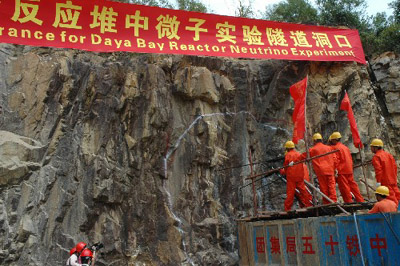Construction began Saturday in Shenzhen, south China's Guangdong Province, on an experimental facility which will offer a platform for Chinese and foreign scientists to work together to research a new kind of neutrino oscillation.
It was the second biggest cooperative program Chinese high energy scientists have ever conducted with foreign counterparts. The first cooperative venture was in October 1988 when a positive-negative electron collider was built in Beijing.
Scientists from China and the United States have cooperated and carried out legions of scientific research using the collider.
More than 100 people, including government officials and foreign diplomats, including Dr. Robin Staffin, Associate Director of Science in the US Department of Energy, attended Saturday's construction commencement function.
Neutrino Oscillation is a kind of intriguing behavior by a sub-atomic particle called a neutrino.
The new facility is being built in the mountains near two nuclear power plants: Daya Nuclear Power Plant, which has four reactors with a combined thermal output of 11.6 million kw in operation, and the Ling'ao nuclear power plant. Both will serve as sources of anti-neutrinos for the future facility's experiments.
Workers will build three underground experimental halls connected by long tunnels into the mountain, thus shielding the experiment from unwanted cosmic radiation.
Each hall will feature a 10-m deep water-pool within which eight anti-neutrino detectors will be deployed. The water protects the detectors from nearby radiation that interferes with measurements, and helps identify surviving cosmic radiation.
The first experimental hall is expected to be ready by the end of 2008. Commissioning of the detectors in this hall will take place in 2009.
Civil engineering construction is anticipated to last about two years, with installation of the last detector scheduled for 2010.
Upon completion of the new facility, more than 190 scientists from six countries and regions including China, Hong Kong, Taiwan, the United States and Russia will come over to do research work, according to Chen Hesheng, Chief of the Institute of High Energy Physics with the Chinese Academy of Sciences (CAS).
The facility will have a budget of 250 million yuan (about US$31.25 million). China will be responsible for infrastructure construction and construction of the first four detectors, while the United States will be responsible for making of the rest of the detectors.
Wang Yifang, chief scientist on the experiment, said he felt confident that the program would make important contributions toward finding new breakthroughs in China's particle physics research, establish new horizons in global neutrino research, and improve the overall strength of Chinese science and technology.
(Xinhua News Agency October 14, 2007)


